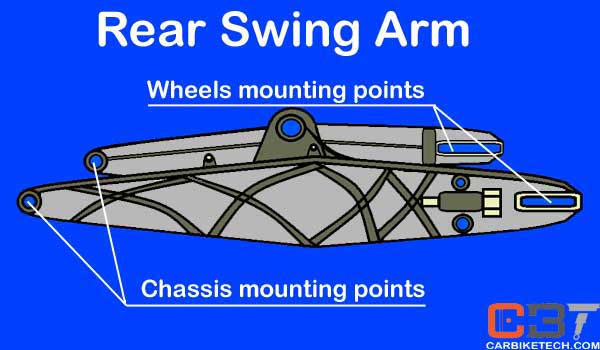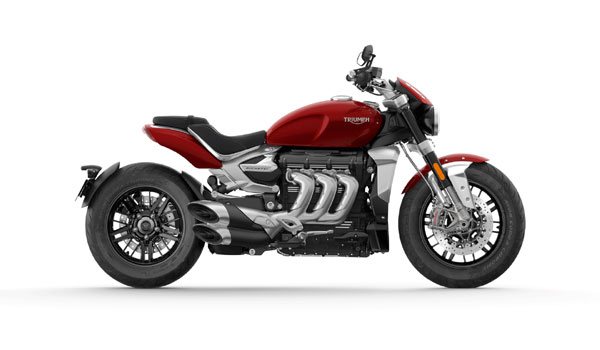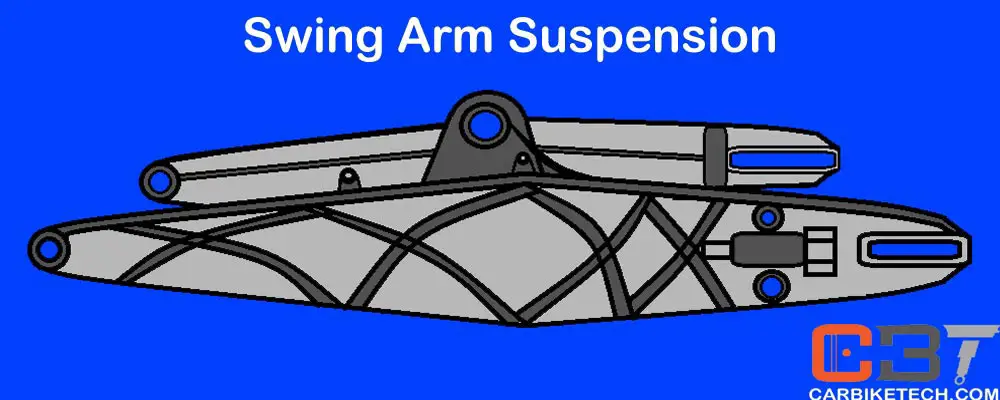What Is Swingarm Suspension & How Does It Work?
The motorcycle rear suspension mainly consists of a telescopic shock-absorber on each side and swingarms. In some countries, manufacturers call a swingarm a “swinging arm”. However, its original name was swing fork or pivoted fork. However, it is the main part of the rear suspension setup of most modern motorcycles and ATVs. It holds the rear axle firmly while pivoting vertically. Hence, the name. It allows the suspension to absorb the road shocks.

Initially, motorcycles did not have a dedicated rear suspension set up. This is mainly because their frames were little more than stronger versions of a bicycle’s typical diamond frame. The manufacturers tried many types of suspension, including the leaf-spring, suspended swingarm, and cantilevered coiled-spring type. The plunger suspension, in which the axle moved up and down the two vertical posts, became popular right away after World War II. In the latter, the movement in each direction was against coiled springs.
Some manufacturers use swingarm designs for the front forks which are more robust than telescopic forks. Particularly, sidecar motocross outfits frequently use swing arm front forks. Some manufacturers used swingarm for the front suspension of scooters. In this case, it helps in simplifying the scooter’s maintenance. In motorcycles with shaft drive, the shaft housing formed the left side swingarm.
Types of swingarm:
- Swinging fork
- Cantilever
- Parallelogram suspension

Swinging fork – This design consists of a pair of parallel pipes holding the rear axle at one end while pivoting at the other. Manufacturers mounted a pair of shock absorbers just before the rear axle and attached to the frame, below the seat rail.
Cantilever – This is an extension of the swinging fork where a triangular frame transfers the movement to compress shock absorber/s generally mounted in front of the swingarm. The Matchless, HRD-Vincent Motorcycle and Yamaha used this type of swingarm. However, on the Harley-Davidson Softail, it works in reverse order with the shock absorbers get extended rather than being compressed.
Watch swingarm in action here:
Parallelogram Suspension
Parallelogram Suspension was first launched commercially in 1985 on the Magni “Le Mans”. Magni called this system Parallelogrammo. However, other manufacturers developed various parallelogram systems.
While a chain-driven bike would “squat” at the rear under acceleration, a shaft drive machine would do the opposite. It causes the seat (and rider) to rise upwards. This phenomenon is known as “shaft-jacking”. This anti-intuitive sensation can be confusing to riders, and parallelogram suspensions seek to neutralize such unwelcome torque reactions.
Single-sided:
This is a type of swingarm in which manufacturers lay the swingarm only one side of the rear wheel. Thus, allowing the rear wheel to be mounted like a car wheel (unlike the conventional motorcycle double-sided swingarm). Traditionally, manufacturers use single-sided swingarms on small motorcycles or scooters, where a robust chain case acts as the swing-arm; linking the engine and rear wheel. Single-sided swingarms need to be much stiffer than the double-sided versions, to bear the extra torsional forces. And, as a result, they are usually heavier than double-sided arms. Having a single mounting point ensures proper wheel alignment. Triumph’s Rocket 3 is one such bike with this type of design.

Properties:
- Should be of strong material
- It should be light-weight
- Should be easily serviceable
- It should have a twisting ability / torsional strength
Hence, manufacturers employ this type of suspension on some of the high-performance bikes. In conclusion, this type of bike suspension provides torsional strength and stability to the motorcycle.
Watch importance of the swingarm by MotoGP expert here:
Read More: What Is A Telescopic Front Fork?>>
